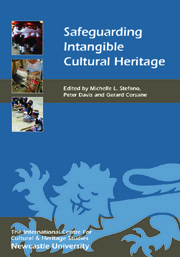Touching the Intangible: An Introduction
Published online by Cambridge University Press: 05 February 2013
Summary
The need to promote, protect and revitalise cultural expressions and practices of communities, groups and individuals from throughout the world is gaining an increasing amount of recognition and, thus, importance at international and national levels. Indeed, the contribution of culture to strengthening the livelihoods of people, as well as their agency within broader social, economic, political and environmental contexts, is an area that deserves greater attention. Viewed as the nuanced components of our cultural diversity, a great number of cultural expressions, or ‘intangible cultural heritage’, are considered to be threatened with extinction as a result of the homogenising forces of globalisation, or the rise of one, mass culture. For instance, changes in local economies, which may lead to higher unemployment, the creation of new industries and migration, can affect the vitality of certain cultural practices and identity expressions. In response, transnational initiatives are in the process of being implemented to counteract their potential degradation and disappearance.
Usage of the term ‘intangible cultural heritage’ has grown in the past several decades on an international scale. Without presenting its official definition (or definitions), it can be deduced that the term relates to forms of cultural heritage that lack physical manifestation. It also evokes that which is untouchable, such as knowledge, memories and feelings. In this light, it can also be suggested that intangible cultural heritage represents everything: the immaterial elements that influence and surround all human activity.
- Type
- Chapter
- Information
- Safeguarding Intangible Cultural Heritage , pp. 1 - 6Publisher: Boydell & BrewerPrint publication year: 2012



